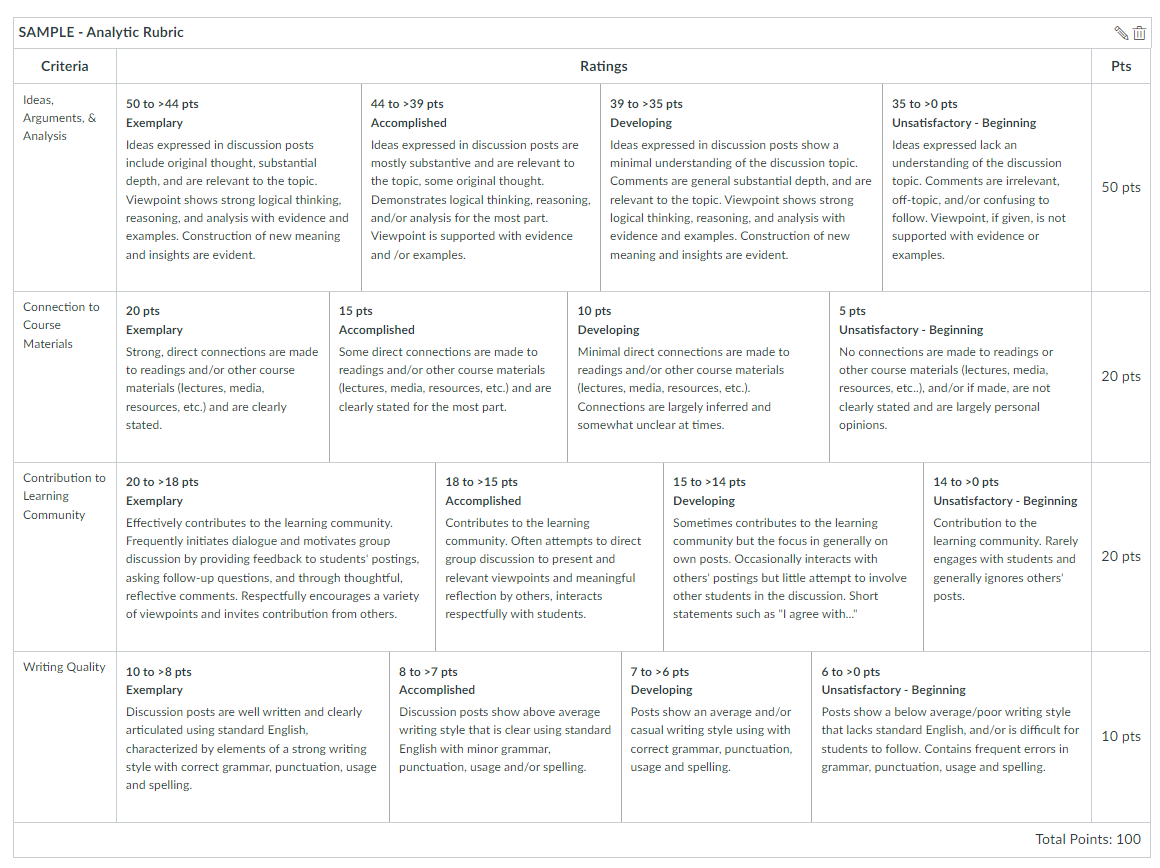A rubric can be used to inform students of assessment expectations and may also be used as a scoring tool to evaluate graded work in Blackboard. The goal is to provide a clear description(s) of the work at varying levels of performance. When you allow students access to rubrics before they complete their work, you provide transparency into your grading methods. Students can use the rubric to organize their efforts to meet the requirements of the graded work.
When to use a rubric? Rubrics are often used for Subjective Assignments. Higher order Bloom’s Taxonomy such as Apply / Analyze / Evaluate / Create – Examine, Compare, Justify, Compose and Investigate. The evaluation of these types of assignments are inherently subjective as there are many factors to be considered, or criteria that make up a comprehensive answer. Review the action verbs in your current assessments.
Steps to Design a Rubric
Step 1: Identify your learning outcome-consider your action verb. (Blooms taxonomy verb wheel)
Step 2: Choose your type of rubric including: Analytic vs Holistic and Points vs Point Range.
Point/Percent: Only one point/percent option provided for each level.
Point/Percent Range: A range of values provided for each level.
Analytic Rubric – Each criterion (action, dimension) is evaluated separately, and assigned different degrees of quality. This is the most common form of a rubric. Advantages of this type of rubric are it provides useful feedback on areas of strength and weakness. Criterion can be weighted to reflect the relative importance of each dimension. The main disadvantages is it takes more time to create and use than a holistic rubric.
 Holistic Rubric – Consists of a single scale with all criteria to be included in the evaluation being considered together (e.g., clarity, organization, and mechanics). The main advantage of a holistic rubric is it saves time by minimizing the number of decisions raters make. Disadvantages are it does not provide specific feedback for improvement. When student work is at varying levels spanning the criteria points it can be difficult to select the single best description. Criteria cannot be weighted.
Holistic Rubric – Consists of a single scale with all criteria to be included in the evaluation being considered together (e.g., clarity, organization, and mechanics). The main advantage of a holistic rubric is it saves time by minimizing the number of decisions raters make. Disadvantages are it does not provide specific feedback for improvement. When student work is at varying levels spanning the criteria points it can be difficult to select the single best description. Criteria cannot be weighted.
 Step 3: Identify the levels and criteria by considering your idea of the perfect submission.
Step 3: Identify the levels and criteria by considering your idea of the perfect submission.
Common to both types of rubrics is a levelling system. Some examples include:
- Needs improvement, Satisfactory, Good, Exemplary
- Beginning, Developing , Accomplished, Exemplary
- Needs Improvement, Proficient, Exceeds
Some rubrics use general criterion. Some examples include:
- Critical thinking
- Content
- Writing mechanics
- Visuals
Using specific criterion allows you to align your rubric criteria to the course learning outcomes in your assessment. You could also use specific questions from your assessment to build your criterion. See example below:
- Summarize the importance of recent contributions to the field of modern genetics.
- Discuss how the condition is inherited. Remember to comment on dominance, recessivity, sex-linkage.
Step 4: Develop or adopt/adapt an existing rubric.
You can review and edit existing rubrics. Or create a new one for the assessment. You can create a PDF or your rubric to share in your course.
Step 5: Share the rubric with students. Your options include:
- Adding the rubric to the Assessment in the Canvas Learning Management System
- Adding the PDF document in the module as a guide for students to follow
- Handing out the rubric document in class
